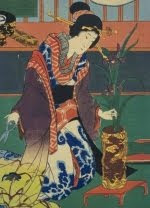Abstract freestyle vertical arrangement.
Metal mesh, taxus, trumpet lily, steel grass, plasticine.
Untraditional material. Repeating the shape of the container.
Metal mesh, taxus, trumpet lily, steel grass, plasticine.
Untraditional material. Repeating the shape of the container.
Developing personal creativity is one of the main goals of Sogetsu ikebana. But in ikebana creativity is never free from tradition. Creativity means being able to interpret tradition and invest something from your own personal history into it. In the Sogetsu School freestyle ikebana is divided into three distinct forms: Naturalistic freestyle, abstract freestyle and avant-garde style. This categorisation is corresponding with the development of Sogetsu ikebana from the 1930s to the 1990s.
Abstract freestyle has a focus on the form, often based on line and mass, and on geometric lines. The style is not restricted to traditional symbolism and the seasons of nature (as apposed to naturalistic style), but the ikebana arrangement usually still has a message. Hiroshi Teshigahara, 3rd. iemoto of the Sogetsu School, stressed the importance of practicing geometric painting to develop a sense of balance in geometric composition. His distinct interpretation of abstract freestyle seems to be especially in focus from the 1980s and corresponds with tendencies in art and architecture. Geometric abstraction is an abstract, non-objevtive form of art based on geometric shapes. Typical representatives for the first generation would be Kandinsky, Malevich and Mondrian. Their pioneering ideas were followed up by the next generation of artists, such as Victor Vasarely. Sogetsu abstract freestyle also has a strong focus on the use of unorganic materials, defined as untraditional materials. This is a heritage from Sofu Teshigahara, 1st. iemoto and founder of the school, who introduced dry plant materials and untraditional materials in ikebana.
If you want to see another interpretation of the same idea and materials as the ikebana in this blog post, I recommend that you take a look at the blog of Tatjana Felberg who is also a student of my ikebana teacher. Her blog is written in Serbian but it works okay translating it with google translate.
Abstract freestyle has a focus on the form, often based on line and mass, and on geometric lines. The style is not restricted to traditional symbolism and the seasons of nature (as apposed to naturalistic style), but the ikebana arrangement usually still has a message. Hiroshi Teshigahara, 3rd. iemoto of the Sogetsu School, stressed the importance of practicing geometric painting to develop a sense of balance in geometric composition. His distinct interpretation of abstract freestyle seems to be especially in focus from the 1980s and corresponds with tendencies in art and architecture. Geometric abstraction is an abstract, non-objevtive form of art based on geometric shapes. Typical representatives for the first generation would be Kandinsky, Malevich and Mondrian. Their pioneering ideas were followed up by the next generation of artists, such as Victor Vasarely. Sogetsu abstract freestyle also has a strong focus on the use of unorganic materials, defined as untraditional materials. This is a heritage from Sofu Teshigahara, 1st. iemoto and founder of the school, who introduced dry plant materials and untraditional materials in ikebana.
If you want to see another interpretation of the same idea and materials as the ikebana in this blog post, I recommend that you take a look at the blog of Tatjana Felberg who is also a student of my ikebana teacher. Her blog is written in Serbian but it works okay translating it with google translate.












No comments:
Post a Comment